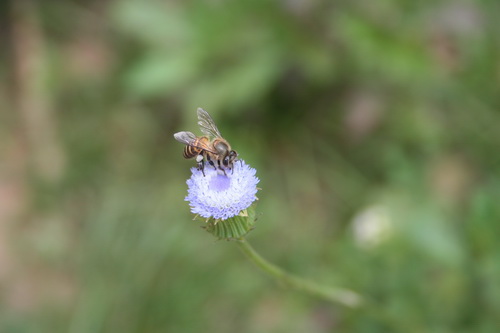According to risk sensitive foraging theory, animals forage in ways that not only maximize net caloric intake, but also minimize their probability of starvation (i.e. minimum food requirement). Previous studies have shown that honey bee foragers prefer constant rewards over variable rewards. Prof. TAN Ken of Xishuangbanna Tropical Botanical Garden (XTBG) and his collaborators studied the risk sensitivity of honey bees by studying the risk mitigation strategy as they travel between their nest and a food source.
The amount of food (used as ‘fuel load’) taken by a foraging bee on her outward journey may be an objective measure of her perception of the riskiness of the foraging trip she is embarking on. The researchers examined the fuel loads carried on their outward journeys to a familiar food source that provided either a constant reward or a variable reward.
The researchers trained honey bee foragers to a feeder located 1.2 km from each of four colonies. They hypothesized that an individual bee that perceived her foraging trip as being risk should carry more fuel as she perceived that the energy budget of the trip may place her at risk of starvation before she can return to the nest.
They found that crop concentration and volume were influenced by feeder variability. When a feeder offered variable rewards, honey bees (Apis cerana) carried 12.7% greater volume of fuel than that they carried when a feeder offered constant reward.
The study showed that when honey bee foragers were faced with variable rewards at a feeding site, they reduced the risk by increasing the volume, and possibly the concentration of the fuel load they carried. Fuel load volume seemed to provide a direct measure of a forager’s perception of the riskiness of a foraging trip, and may provide a novel experimental tool for determining how foragers rank riskiness.
The study entitled “Individual honey bee (Apis cerana) foragers adjust their fuel load to match variability in forage reward” has been published in Scientific Reports.
Contact
TAN Ken, Ph.D Principal Investigator
Key Laboratory of Tropical Forest Ecology, Xishuangbanna Tropical Botanical Garden, Chinese Academy of Sciences, Mengla, Yunnan 666303, China
Tel: 86-871-65227717
Fax: 86-871-65227358
E-mail: kentan@xtbg.ac.cn

Honey bee foraging in the field. (Image by TAN Ken) |

